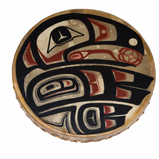History
Historically, "art" as a decorative concept did not traditionally exist among these indigenous people. Objects were utilitarian, although decorated in ways that conveyed images of spiritual or physical activity. It was not until Europeans and Asians first made contact with the indigenous people of coastal Alaska in the 17th century that such non-utilitarian art objects began to be traded in exchange for metal implements, cloth, and foodstuffs such as tea, flour, or sugar.
Many objects traded were valued for their functionality: clothing woven of grass, harpoon tips carved from the ivory tusk of the walrus; rainproof outerwear sewn from membranes in the intestines of seals; and animal skins valued for their warmth and durability. Gradually, these items were refined to be more decorative, as a way to increase their value in trade. For example, awalrus tusk might be etched with many hunting scenes depicting life of the coastal people; later, this technique would come to be known as "scrimshaw" when brought back to New England on whaling ships. Elaborate patterns in beadwork were designed as the beads themselves arrived through trade; Regalia of all types used for ceremonial purposes – masks, woven clothing, hats, dance fans – all became souvenirs for the whalers and explorersof the 17th, 18th and 19th centuries. Even the toweringtotem poles from Southeastern Alaska found their way back to the East Coast of the United States, where they formed the basis of many museum collections.
While the art forms were and still are as different as the cultures of the Native people who made them – Athabascan Indians of the vast Interior, Inupiaq of the Northwestern Arctic coasts; Yupik and St. Lawrence Island Yupik of the Bering Sea coast; Aleuts and Alutiiq people from the Aleutian islands; and theTlingit, Haida and Tsimshian Indians often known as Northwest Coastal tribes – they commonly evoke references to living in harmony with nature and all its many creatures. No part of an animal hunted, fished or trapped could be wasted, for example, so one might see boots or "mukluks" made of bearded seal skin for soles, salmon skin for the outer layer, and straps of caribou or deerskin, perhaps even dyed with berries. As Native people lived off the land and the sea, their relationships to a particular place could always be seen in their objects in both physical and metaphorical terms. As traditions evolved through more "westernization" withRussian America in the 17th century and Territorial Alaska beginning in 1867 and finally the creation of Alaska as our 49th State in 1959, so did their art forms.
All are continually evolving, blurring the distinction between what an art critic today might want to categorize as "traditional" versus "contemporary" Native art. And contemporary, international art values have a place in Native Alaska art. Wall-size paintings, three-dimensional mobiles, life-size bronze castings and marblesculptures, to name just a few categories, fill galleries alongside bears carved from whalebones, cribbage boards honed from full-length walrus tusks, fine jewelry etched of copper and silvers; Nephrite jade and musk ox horn polished into bracelets, bentwoodboxes carved from coastal white cedar trees; and baskets of infinite shapes and designs, from birch bark or woven spruce root, beach grasses or the baleen from a bowhead whale, all intricately woven and shaped into vessels of all sizes.






